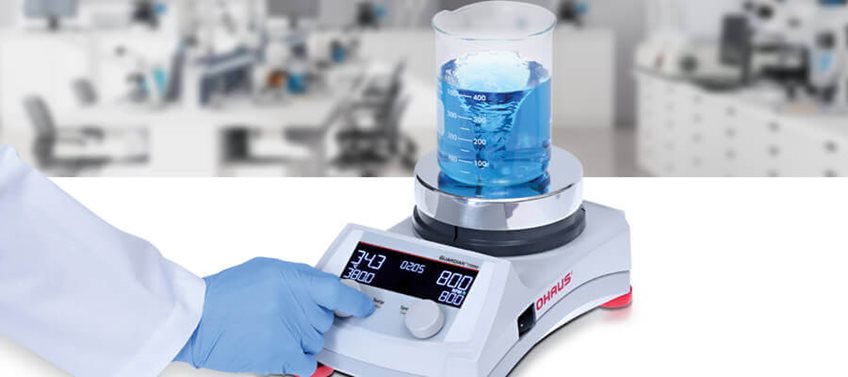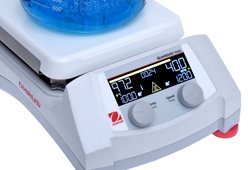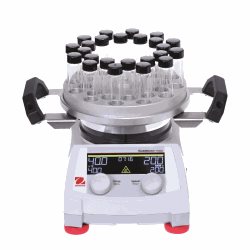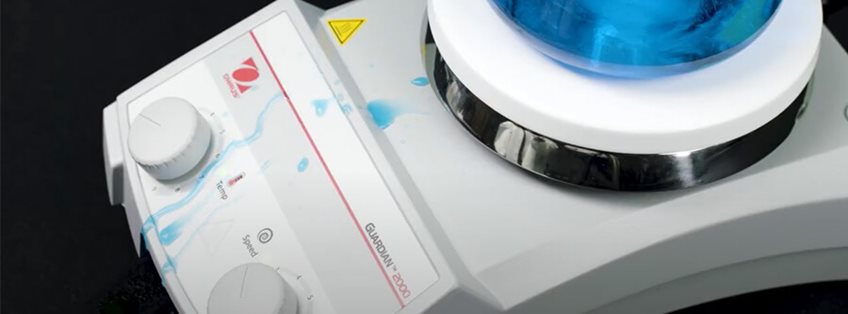
What differentiates the Guardian 7000 Hotplate Stirrers?
SmartLink™
Provides long-range user detection for improving safety when using the heating function.
SmartPresence™
Detects when a user is nearby and safely turns off the heating function when no one is detected.
SmartHeat™
Allows users to control the maximum temperature, preventing overheating of sensitive samples.
SafetyHeat™
Our industry leading internal protection system assures safety in heating applications with dual-monitoring of system health.
SmartRate™
Allows users to safeguard sensitive applications with precise control of temperature and speed ramp rates.
SmartHousing™
Ensures that every Guardian hotplate stirrer is consistently safe to use at high temperature settings by remaining cool to the touch. The innovative design is easy to clean and channels spills away from the internal components, as well as being constructed from a chemical resistant material for long-term use in the lab.
How can the Gu ardian 7000 safeguard sensitive applications?
ardian 7000 safeguard sensitive applications?
For precise sample control with the
Guardian 7000, use the included temperature probe and enable SmartRate to select fast or slow temperature and speed ramp rates. SmartHeat allows lab users to limit the maximum temperature of the hotplate stirrer preventing overheating of sensitive samples -- keeping the user and samples safe.
What are the benefits of using the Guardian Ser ies Hotplate Stirrers with round top plates?
ies Hotplate Stirrers with round top plates?
The Guardian round top models are ideal for biochemistry and chemistry labs that carry out complex heating and stirring applications and increase productivity by utilizing multiple positions to perform experiments in parallel. Round top models save valuable bench space and accept a wide range of aluminum block accessories that can accommodate standard vials and test tubes.
What type of Guardian top plate material best suits the lab? Ceramic, Ceramic Coated Steel, Aluminum, or Resin
Ceramic, ceramic-coated steel, aluminum and resin top plates are all suitable for lab use and each material has its benefits.
Ceramic top plates are chemical-resistant and safer if working with corrosive chemicals that may splash onto the plate surface. They can withstand higher temperatures up to 500 °C, and can be wiped clean.

The white surface of a ceramic or ceramic-coated steel top plate is preferable for quantitative chemical analysis or other work where clear visibility of the sample color is required.
The edges of a ceramic top plate may not be as hot as the center. This may not be suitable if uniform heating over the entire plate surface is needed for the application.
Aluminum top plates offer more uniform temperature over the entire heating surface, and will not crack or chip, and will withstand accidental handling. Ceramic-coated steel also provides more uniform temperature across the heating surface with a white surface to easily view the sample. These materials have a lower maximum temperature than the full ceramic top plates.
The durable, chemical-resistant resin top plate on stir only models provides a bright white surface for clear visibility. This long-lasting resin material will not chip or crack if mishandled.
To avoid thermal shock, glassware should be used on ceramic top plates and heating of metallic vessels should be avoided. Ceramic top plate units are also not suitable for sandbaths or any vessel that may reflect heat back onto the surface which may cause thermal shock.
Which safety features are built into the Guardian Series for use in academic settings?
All Guardian heating models feature a prominent 13 mm Hot Top Indicator Light to alert the end user that the top plate surface is hot and not safe to the touch. This hot top light stays on even when the power switch is turned off. This important feature will help prevent accidents in all settings and especially academic labs where students are using hotplates and hotplate stirrers.
The Guardian 2000 models feature simple overheat protection where the unit will turn off the heating function if the temperature exceeds the upper limit.
Guardian 3000, 5000 and 7000 Series heating models feature SafetyHeat™; an industry leading early detection system that uses two independent safety controls to monitor the electronics and stop heating before an overtemperature condition occurs. This important feature protects the sample, the user, and the lab by preventing accidents that occur due to overheating samples.
 The digital control Guardian 3000, 5000 and 7000 models are designed so the user must press the knob to start the heating and stirring function. This knob press is also needed to change a setting. This secondary step provides an additional layer of safety by making the user acknowledge the setting. The analog control Guardian 2000 are simple knob control and easy to use where turning the knob starts the function or adjusts the current setting.
The digital control Guardian 3000, 5000 and 7000 models are designed so the user must press the knob to start the heating and stirring function. This knob press is also needed to change a setting. This secondary step provides an additional layer of safety by making the user acknowledge the setting. The analog control Guardian 2000 are simple knob control and easy to use where turning the knob starts the function or adjusts the current setting.
All Guardian Series models have chemical-resistant housings, and feature an easy-to-clean design that channels spills away from internal components, and the front panel which protects the unit. The Guardian 5000/7000 Series models are constructed with the SmartHousing™ that remains cool to the touch at all temperature settings. The Guardian 2000/3000 Series feature a rugged metal housing that will withstand harsh conditions in the lab.
Download the Guardian Series brochure
Visit the Product Pages:
Guardian 7000
Guardian 5000
Guardian 3000
Guardian 2000